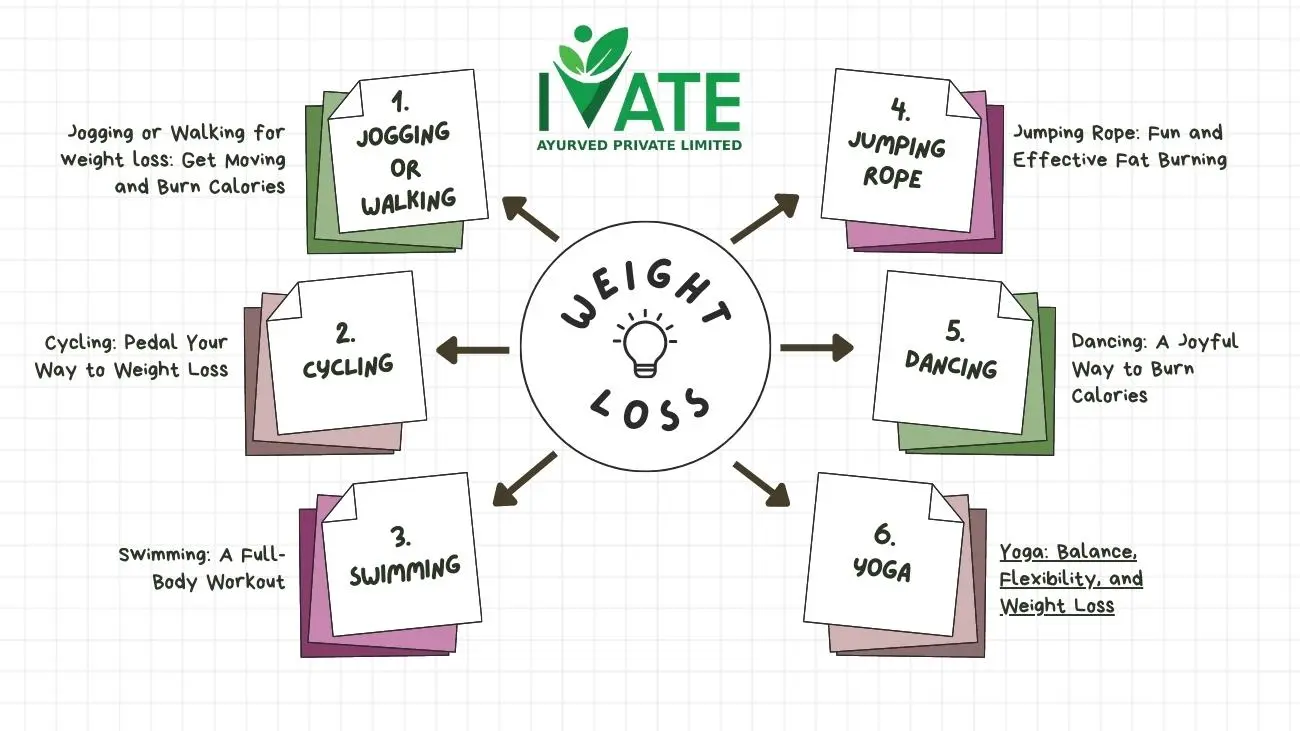10 Effective Exercises for Weight Loss Achieve Your Fitness Goals
Walking is a simple and effective form of exercise that can help you lose weight and improve your overall health. Whether you’re a beginner or an experienced fitness enthusiast, incorporating walking into your daily routine can make a significant difference in your weight loss journey. In this article, we will explore ten expert tips on how to optimize your walking routine for weight loss.
Table of contents
- Introduction: Importance of Exercise for Weight Loss
- The Benefits of Walking for Weight Loss
- Jogging or Walking for weight loss: Get Moving and Burn Calories
- Monitoring Your Heart Rate: Boost Your Metabolism
- Strength Training: Build Lean Muscle Mass
- Cycling: Pedal Your Way to Weight Loss
- Combining Walking with a Healthy Diet
- Swimming: A Full-Body Workout
- Jumping Rope: Fun and Effective Fat Burning
- Burpees: Full-Body Conditioning
- Dancing: A Joyful Way to Burn Calories
- Yoga: Balance, Flexibility, and Weight Loss
- Conclusion
Introduction: Importance of Exercise for Weight Loss
Before we get into the exact exercises, it’s important to understand the role of exercise in your weight loss journey. Regular physical activity not only helps you burn calories, but it also increases your metabolism, improves your cardiovascular health, and improves your general well-being. Exercise, when combined with a good diet, becomes a potent tool for weight loss.
The Benefits of Walking for Weight Loss
Walking is a low-impact exercise that offers numerous benefits for weight loss. It helps burn calories, improve cardiovascular health, strengthen muscles, and reduce stress levels. Walking also boosts metabolism, increases energy levels, and enhances overall well-being. By incorporating these expert tips into your walking routine, you can maximize its effectiveness in shedding those extra pounds.
- Increased Calorie Burn: Walking is a low-impact aerobic exercise that helps you burn calories.
- Improved Metabolism: Engaging in regular walking can help boost your metabolism.
- Preserved Lean Muscle: Walking is a weight-bearing exercise that helps preserve lean muscle mass while burning fat.
- Reduced Appetite and Cravings: Walking can help suppress appetite and reduce cravings, making it easier to stick to a calorie-controlled diet.
- Improved Mental Well-being: Walking is not only beneficial for physical health but also for mental well-being. Regular walking releases endorphins, which are natural mood boosters, helping to reduce stress, anxiety, and symptoms of depression. By improving your mental well-being, walking can indirectly support weight loss by reducing emotional eating and promoting a positive mindset.

Jogging or Walking for weight loss: Get Moving and Burn Calories
Walking or jogging is an excellent exercise choice for beginners and those seeking low-impact workouts. Lace-up your shoes, head outdoors, and start moving. Brisk walking or jogging can help you burn calories, improve cardiovascular health, and strengthen your leg muscles. Aim for at least 30 minutes of moderate-intensity walking or jogging most days of the week.
- Increased Calorie Burn: Jogging or walking at a moderate to high intensity can help you burn a significant number of calories. Both activities engage multiple muscle groups, leading to a higher metabolic rate and increased energy expenditure. By incorporating jogging or brisk walking into your routine, you can create a calorie deficit, which is essential for weight loss.
- Improved Cardiovascular Health: Jogging and walking are excellent aerobic exercises that work your heart and lungs, improving cardiovascular fitness. Regular participation in these activities can strengthen your heart, lower blood pressure, and reduce the risk of heart disease. The increased blood circulation also supports overall health and well-being.
- Muscle Tone and Strength: While jogging primarily engages your lower body muscles, walking also involves your core and upper body to a lesser extent. By consistently jogging or walking, you can strengthen and tone the muscles in your legs, buttocks, and abdomen. This can lead to improved posture, increased muscle definition, and a more sculpted physique.
- Stress Relief and Mental Well-being: Engaging in physical activity like jogging or walking can have a positive impact on your mental health. These exercises release endorphins, which are natural mood-boosting hormones, and help to reduce stress, anxiety, and depression. Regular jogging or walking sessions can provide a sense of accomplishment, improve self-esteem, and enhance overall mental well-being.
- Accessibility and Versatility: Jogging and walking are simple, accessible activities that can be performed almost anywhere and at any time. You don’t need expensive equipment or a gym membership to get started. Whether you choose to jog in a park, walk around your neighborhood, or use a treadmill, you have the flexibility to adapt these exercises to your preferences and schedule.
Monitoring Your Heart Rate: Boost Your Metabolism
Monitoring your heart rate during walking can help you gauge the intensity of your workout. The ideal heart rate range for weight loss varies depending on age and fitness level. Aim to maintain a moderate-intensity heart rate, usually around 50-70% of your maximum heart rate. Utilize a heart rate monitor or wearable fitness tracker to ensure you stay within the target zone for optimal calorie burn.
- Optimal Fat Burning: Monitoring your heart rate allows you to exercise within your target heart rate zone, which maximizes fat burning. By maintaining a specific heart rate range during cardio exercises, you can optimize your metabolism to burn stored fat as fuel, aiding in weight loss.
- Efficient Workouts: Tracking your heart rate helps you gauge the intensity of your workouts. By staying within your target heart rate zone, you ensure that you’re working at an appropriate level for your fitness goals. This helps you avoid under- or over-exertion, making your workouts more efficient and effective.
- Increased Calorie Burn: When you exercise at a higher heart rate, your body requires more energy and burns more calories. By monitoring your heart rate, you can ensure that you’re pushing yourself enough to increase calorie burn during your workouts. This can be particularly beneficial for weight loss and improving overall fitness.
- Cardiovascular Fitness Improvement: Regularly monitoring your heart rate during workouts allows you to track your progress over time. As your cardiovascular fitness improves, you may notice that your heart rate is lower during exercises that are used to push you harder. This indicates that your heart is becoming more efficient, which is a positive sign of improved fitness.
- Personalized Training Zones: Monitoring your heart rate enables you to establish personalized training zones based on your fitness level and goals. These zones help you tailor your workouts to specific objectives, such as fat burning, endurance building, or improving aerobic capacity. By exercising within the appropriate heart rate range, you can optimize your metabolism and achieve desired results more effectively.
Strength Training: Build Lean Muscle Mass
Strength training is vital for weight loss as it helps build lean muscle mass. Muscles are more metabolically active than fat, meaning they burn more calories at rest. Include exercises like squats, lunges, push-ups, and dumbbell curls in your strength training routine. Aim to work all major muscle groups at least twice a week.
- Increased Metabolism: Strength training stimulates the growth of lean muscle mass. Since muscle tissue is metabolically active, having more muscle increases your resting metabolic rate. This means that even at rest, your body burns more calories, aiding in weight management and fat loss.
- Improved Body Composition: Strength training helps to reduce body fat while increasing muscle mass. This leads to a more toned and defined physique. Building lean muscle can enhance your overall body shape, increase strength, and improve your body composition.
- Enhanced Strength and Functional Fitness: Strength training exercises target specific muscle groups, leading to increased strength and functional fitness. By progressively overloading your muscles with resistance, you can become stronger, which can improve your performance in daily activities and sports.
- Increased Bone Density: Regular strength training helps to promote bone health and increase bone density. This is particularly important for preventing osteoporosis, especially as you age. By putting stress on your bones through resistance exercises, you stimulate bone remodeling and improve bone strength.
- Injury Prevention and Joint Stability: Strengthening the muscles around your joints helps to stabilize them and protect against injuries. Strength training improves joint integrity and stability, reducing the risk of strains, sprains, and other musculoskeletal injuries. It can also alleviate joint pain by providing support and improving overall joint function.
Cycling: Pedal Your Way to Weight Loss
Cycling is a fantastic aerobic exercise that targets your leg muscles and gets your heart pumping. Whether you prefer outdoor cycling or stationary biking, this activity can be adapted to various fitness levels. Set goals, challenge yourself with inclines or resistance levels, and enjoy the benefits of improved endurance and weight loss.
Helpful advice about How to workout with cycling for weight loss
Set up your cycling:
- Adjust the seat height so that your leg is slightly bent when the pedal is at its lowest point.
- Check that the handlebars are at a comfortable height and within easy reach.
- Ensure the tires are properly inflated and the brakes are in good working condition.
Vary your cycling routine:
- Mix up your cycling sessions to keep it interesting and challenge your body.
- Incorporate both steady-state rides and interval training.
- Steady-state rides involve maintaining a consistent pace for an extended period, while interval training involves alternating between high-intensity bursts and recovery periods.
Increase intensity:
- Gradually increase the intensity of your cycling workouts over time.
- You can do this by adding resistance, increasing your speed, or tackling more challenging terrains.
- Push yourself, but listen to your body and avoid overexertion.
Track your progress:
- Keep a record of your cycling workouts to track your progress.
- Note the duration, distance, and intensity of each session.
- Monitoring your progress can help motivate you and adjust your workouts accordingly.
Maintain proper form:
- Maintain a good cycling posture by keeping your back straight and your core engaged.
- Relax your shoulders, grip the handlebars gently, and keep your elbows slightly bent.
- Pedal in smooth, circular motions, pushing and pulling with both legs.
Stay hydrated and fuel your body:
- Drink water before, during, and after your cycling sessions to stay hydrated.
- Consume a balanced diet that includes carbohydrates, protein, and healthy fats to provide the energy your body needs for cycling and recovery.
Cool down and stretch:
- Finish your cycling workout with a cool-down period of 5-10 minutes of easy pedaling.
- Follow it up with stretching exercises to improve flexibility and prevent muscle tightness.
Combining Walking with a Healthy Diet
While walking can contribute to weight loss, it is essential to combine it with a healthy and balanced diet for optimal results. Focus on consuming nutrient-dense foods such as fruits, vegetables, lean proteins, whole grains, and healthy fats. Avoid processed foods, sugary beverages, and excessive calorie intake. Remember that a calorie deficit is necessary for weight loss, so aim to consume fewer calories than you burn through walking and daily activities.
- Weight Loss: Combining walking with a healthy diet can be an effective strategy for weight loss. Walking is a low-impact exercise that helps burn calories and increase your overall energy expenditure. When paired with a nutritious diet that promotes calorie control, you create a calorie deficit, which can lead to sustainable weight loss.
- Improved Heart Health: Walking and maintaining a healthy diet both contribute to improved heart health. Regular walking helps lower blood pressure, reduce LDL (bad) cholesterol levels, and improve overall cardiovascular fitness. A healthy diet, rich in fruits, vegetables, whole grains, lean proteins, and healthy fats, supports heart health by providing essential nutrients and reducing the risk of heart disease.
- Increased Energy Levels: Engaging in regular walking and consuming a healthy diet can boost your energy levels. Walking increases blood circulation, delivering oxygen and nutrients to your cells, which can leave you feeling more energized. A balanced diet, with a focus on whole foods and proper hydration, provides the necessary nutrients to support optimal energy production.
- Better Digestive Health: Walking can aid in digestion by stimulating the muscles in your abdomen, helping to move food through your digestive system more efficiently. Pairing walking with a healthy diet that includes fiber-rich foods, such as fruits, vegetables, and whole grains, can further support digestive health by promoting regular bowel movements and preventing constipation.
- Overall Well-being: Combining walking with a healthy diet can have a positive impact on your overall well-being. Walking is a form of physical activity that releases endorphins, which are natural mood-boosting hormones. Regular physical activity and a nutrient-rich diet can reduce stress, improve sleep quality, enhance cognitive function, and promote a sense of well-being and vitality.

Swimming: A Full-Body Workout
Swimming is a low-impact exercise that engages your entire body, making it an ideal option for individuals with joint issues. It provides a full-body workout, increases muscle tone, and burns calories effectively. Dive into the pool, swim laps, or try water aerobics to add variety to your routine and promote weight loss.
- Full-Body Workout: Swimming engages multiple muscle groups in your body, offering a comprehensive full-body workout. It targets muscles in your arms, shoulders, back, core, hips, and legs. By incorporating different swimming strokes and movements, you can strengthen and tone your entire body while improving overall muscle definition.
- Low-Impact Exercise: Swimming is a low-impact exercise, which means it puts less stress on your joints compared to high-impact activities like running or jumping. This makes it an ideal exercise for individuals with joint pain, arthritis, or those recovering from injuries. Swimming allows you to increase your heart rate and burn calories without subjecting your joints to excessive impact or strain.
- Cardiovascular Fitness: Swimming is an excellent aerobic exercise that promotes cardiovascular fitness. It increases your heart rate and improves lung capacity as you continuously move against the resistance of the water. Regular swimming sessions can strengthen your heart, improve circulation, lower blood pressure, and reduce the risk of heart disease.
- Improved Flexibility: Swimming involves stretching and elongating your muscles as you perform different strokes. This promotes improved flexibility and range of motion. Over time, you may notice increased joint mobility and flexibility, which can enhance your overall athletic performance and help prevent injuries.
- Stress Relief and Mental Well-being: Swimming has a calming and meditative effect on the mind. The rhythmic movements, combined with the sensation of water, can help reduce stress and promote relaxation. Swimming also releases endorphins, which are natural mood-boosting hormones, leading to improved mental well-being, reduced anxiety, and better sleep quality.
Jumping Rope: Fun and Effective Fat Burning
Remember the fun you had jumping rope as a child? Well, it turns out that jumping rope is enjoyable and an effective exercise for weight loss. This simple activity improves cardiovascular fitness, and coordination, and burns a significant amount of calories. Incorporate jumping rope into your workouts for a quick and efficient way to shed pounds.
- Efficient Calorie Burner: Jumping rope is a high-intensity cardio exercise that helps burn a significant number of calories in a short amount of time. It engages multiple muscle groups and increases your heart rate, making it an efficient fat-burning workout. Incorporating regular jump rope sessions into your routine can contribute to weight loss and improved body composition.
- Improved Cardiovascular Fitness: Jumping rope is a fantastic aerobic exercise that strengthens your heart and lungs. It enhances cardiovascular endurance by increasing your heart rate and improving the efficiency of your respiratory system. Regular jump rope workouts can lead to better cardiovascular health and improved stamina for other physical activities.
- Full-Body Workout: Jumping rope is a full-body exercise that targets various muscle groups simultaneously. It engages your legs, glutes, core, arms, and shoulders. By jumping rope, you can develop muscular endurance, improve coordination, and tone your muscles. It also helps to improve bone density, especially in the lower body.
- Portability and Convenience: Jumping rope is a versatile exercise that can be done almost anywhere. It requires minimal equipment and space, making it a convenient option for indoor and outdoor workouts. You can easily pack a jump rope when travelling, allowing you to maintain your fitness routine regardless of location.
- Fun and Versatile: Jumping rope is not only effective but also enjoyable. It brings out your inner childlike spirit and can be a fun addition to your fitness regimen. Additionally, jumping rope offers various techniques and styles, such as single jumps, double under, crisscrosses, and more, allowing you to keep the workout challenging and engaging.
Burpees: Full-Body Conditioning
Burpees are a challenging yet highly effective exercise that targets multiple muscle groups while keeping your heart rate up. This full-body movement combines a squat, plank, push-up, and jump. You’ll increase your strength and endurance by performing burpees regularly and burn calories efficiently.
- Full-Body Workout: Burpees engage multiple muscle groups in your body, making it a highly effective full-body exercise. It targets your arms, chest, shoulders, core, glutes, and legs. You can improve muscular strength, endurance, and overall body conditioning by performing burpees.
- Cardiovascular Fitness: Burpees are a high-intensity exercise that elevates your heart rate rapidly. This makes them excellent cardiovascular exercise, helping to improve your cardiovascular fitness and increase your lung capacity. Regularly incorporating burpees into your workout routine can enhance your endurance and stamina.
- Efficient Calorie Burner: Burpees are a compound exercise involving strength training and cardio. Due to their high intensity and full-body engagement, they help burn a significant number of calories in a short period. This makes burpees an effective addition to weight loss or calorie-burning workouts.
- Functional Strength and Agility: Burpees mimic everyday movements, such as squatting, jumping, and push-ups, making them functional exercises. By regularly performing burpees, you can develop functional strength, improve agility, and enhance coordination. These benefits can translate into improved performance in various sports and physical activities.
- Time-Saving and Versatile: Burpees are a time-efficient exercise that requires no equipment and can be performed anywhere. You can do them as a standalone exercise or incorporate them into circuit or high-intensity interval training (HIIT) workouts. Burpees can be modified and scaled based on your fitness level, allowing you to increase the intensity as you progress gradually.
Dancing: A Joyful Way to Burn Calories
Who says exercise has to be boring? Dancing is a fun and engaging activity that can help you achieve your weight loss goals while enjoying yourself. Whether it’s Zumba, hip-hop, or salsa, dancing gets your body moving, burns calories, and improves cardiovascular fitness. So put on some music, let loose, and dance to a fitter you.
- Fun and Enjoyable: Dancing is a form of exercise that brings joy and excitement. It allows you to express yourself creatively and enjoy the music. Unlike traditional workouts, dancing feels more like entertainment than exercise, making it easier to stay motivated and committed to regular physical activity.
- Calorie Burning: Dancing is a great way to burn calories. Depending on the intensity and style of dance, you can achieve a significant calorie burn. Fast-paced dances like salsa, hip-hop, or Zumba can elevate your heart rate, increasing your energy expenditure and aiding in weight management.
- Improved Cardiovascular Health: Dancing is an exercise that gets your heart pumping and improves your cardiovascular health. Regular dancing can strengthen your heart, increase lung capacity, and improve cardiovascular fitness. It also helps to lower blood pressure and reduce the risk of heart disease.
- Enhanced Coordination and Balance: Dancing requires coordination and balance, skills that can be improved through practice. Regularly engaging in dance can enhance your coordination, agility, and balance. These benefits can positively impact your daily life, sports performance, and overall physical functioning.
- Mood Booster and Stress Relief: Dancing releases endorphins, natural mood-enhancing hormones. It can uplift your spirits, boost your mood, and alleviate stress. Dancing lets you let go of everyday worries and immerse yourself in rhythm and movement, providing a mental and emotional escape.
- Full-body workout: Dancing is a fantastic way to engage your entire body in physical activity. It involves many movements, from footwork and legwork to arm movements and core engagement. This full-body workout helps burn calories and tone muscles in various body areas simultaneously.
- Stress reduction: Engaging in dancing can be a fantastic stress-relieving activity. It helps release endorphins, known as “feel-good” hormones, reducing stress levels and promoting a positive mood. Dancing provides an outlet to let go of daily worries and immerse yourself in rhythm and movement, resulting in mental and emotional well-being.
- Increased flexibility and coordination: Dancing requires coordination between body parts and movements. Regular dancing helps improve balance, coordination, and flexibility, making you more agile and graceful in your daily activities. It enhances body awareness and control, contributing to better overall physical performance.
- Social interaction and community: Dancing often involves group classes or social dancing events, creating opportunities for social interaction and community engagement. Participating in dance classes or joining dance groups allows you to meet like-minded individuals, make new friends, and build a supportive network. The social aspect of dancing adds to its positive impact on mental health and overall well-being.
- Versatility and variety: Dancing encompasses various styles and genres, from ballroom and salsa to hip-hop and contemporary. This versatility allows you to explore different dance forms and switch between them based on your preferences and goals. Trying different styles keeps your dance routines fresh and exciting, preventing boredom and encouraging long-term adherence.
- Improved cognitive function: Dancing is not only beneficial for the body but also for the mind. Learning and memorizing dance routines require mental effort and concentration, stimulating brain activity. Regular dancing has been associated with improved cognitive function, including enhanced memory, attention, and multitasking abilities.
- Weight management and body confidence: Dancing regularly can contribute to weight management and body toning. Burning calories and increasing muscle strength helps maintain a healthy weight and shape. Additionally, dancing promotes body confidence and positive body image, as it celebrates movement and self-expression rather than focusing solely on appearance.
Yoga: Balance, Flexibility, and Weight Loss
While yoga may not be as intense in calorie burn as some other exercises on this list, it offers unique benefits for weight loss. Yoga improves flexibility and balance and promotes mindfulness. Certain styles of yoga, such as Vinyasa or Power Yoga, can provide a more vigorous workout and help you burn calories. Additionally, yoga can aid in reducing stress and emotional eating, contributing to weight loss.
- Improved Balance and Stability: Practicing yoga helps improve balance and stability by strengthening the muscles that support your body’s alignment. Balancing poses in yoga requires focus, concentration, and engagement of core muscles, helping you develop better physical and mental balance.
- Increased Flexibility and Range of Motion: Yoga incorporates various stretching exercises that target different muscle groups, promoting flexibility and increasing your range of motion. Regular yoga can enhance your overall flexibility, making daily movements easier and reducing the risk of muscle strains or injuries.
- Stress Relief and Relaxation: Yoga combines physical movement with breath control and mindfulness, calming the nervous system. It helps reduce stress, anxiety, and tension in the body. Through relaxation techniques, such as deep breathing and meditation, yoga can promote a sense of tranquillity and inner peace.
- Weight Management and Body Awareness: Yoga can support weight loss and management efforts. Certain styles of yoga, such as Vinyasa or Power Yoga, offer dynamic and vigorous sequences that can help burn calories and increase cardiovascular activity. Practising yoga cultivates a greater sense of body awareness, encouraging mindful eating and promoting healthier lifestyle choices.
- Strength and Tone: Yoga poses and sequences involve both static and dynamic movements that engage and strengthen various muscle groups. Over time, consistent practice can lead to improved muscle strength, endurance, and toning. Yoga is a holistic exercise that targets superficial and deep stabilizing muscles, contributing to overall body strength.
Tracking Progress and Celebrating Milestones
Tracking your progress is crucial for staying motivated and celebrating your achievements. Record your daily or weekly walks, noting the distance covered and the duration of each session. Use a fitness app or a journal to track your steps, calorie burn, and weight loss. Celebrate milestones, such as reaching a certain distance or losing weight. Reward yourself with non-food treats to reinforce positive behaviors.
- Insight and Awareness: Keeping track of your progress provides valuable insight and awareness of your habits, patterns, and behaviors. It helps you identify what’s working well and what may need adjustment. This self-awareness allows you to make informed decisions, set realistic goals, and make meaningful changes to your routines or strategies.
- Boosted Confidence: Celebrating milestones, no matter how small, boosts your confidence and self-esteem. Recognizing and acknowledging your achievements reinforces the belief in your capabilities and provides a sense of accomplishment. This positive reinforcement can motivate you to strive for further progress and success.
Weight Loss Capsules
FAQ’s Walking For Weight Loss
Walking can contribute to weight loss when combined with a calorie deficit and a healthy diet.
Aim for at least 10,000 daily steps for general health and weight maintenance. To lose weight, you may need to increase your step count.
Both options are effective. Walking outdoors provides fresh air and varied terrain, while a treadmill offers convenience and the ability to control speed and incline.
Walking can help reduce overall body fat, including belly fat when combined with a healthy diet and regular exercise.
Strive for 150 minutes of moderate-intensity walking per week or 75 minutes of vigorous-intensity walking to optimize weight loss.
Conclusion
Incorporating regular exercise into your lifestyle is crucial for weight loss. The ten exercises mentioned in this article provide diverse options suitable for different fitness levels and preferences. Remember to start gradually, listen to your body, and stay consistent with your workouts. Combine these exercises with a balanced diet, adequate rest, and hydration for optimal results. Stay motivated, believe in yourself, and watch as you progress toward your weight loss goals.







The Amazing Benefits of Drinking Water Daily | iVate Ayurveda
[…] meals can help control appetite and calorie intake, aiding in weight loss. It also supports digestion and […]
July 23, 2023 at 9:02 am
vorbelutrioperbir
Hi would you mind letting me know which webhost you’re using? I’ve loaded your blog in 3 different web browsers and I must say this blog loads a lot faster then most. Can you recommend a good web hosting provider at a fair price? Thanks, I appreciate it!
September 4, 2023 at 11:40 pm
Kirti Gupta
We are using Cloud Hosting
September 5, 2023 at 12:30 pm
chinese viagra pills
I loved as much as you’ll receive carried out right here. The sketch is tasteful, your authored material stylish. Nonetheless, you command get an anxious feeling that you’ll be delivering the following. I’ll unquestionably come more formerly again since it’s exactly the same nearly a lot often inside case you shield this hike.
November 25, 2023 at 5:30 am